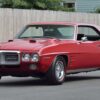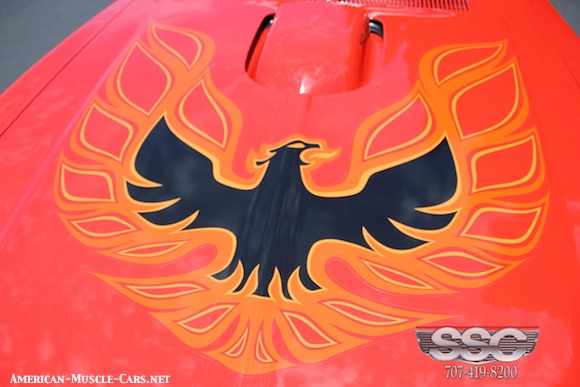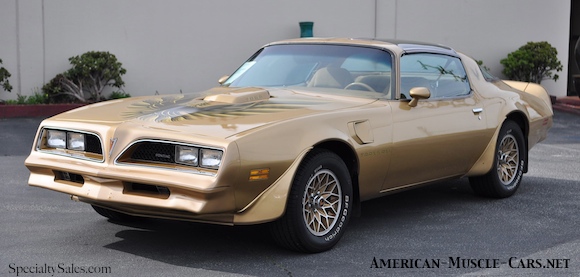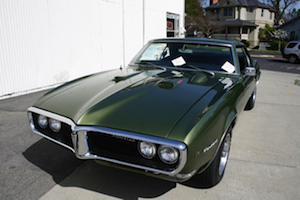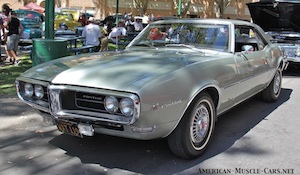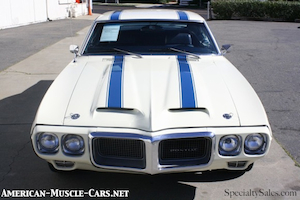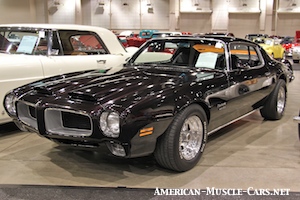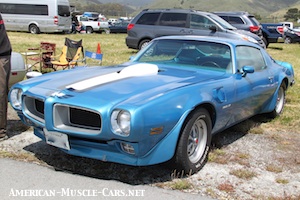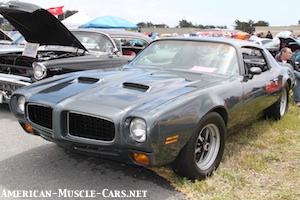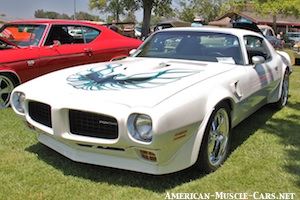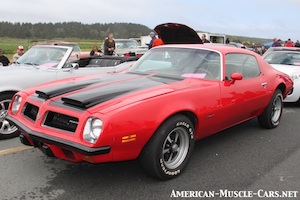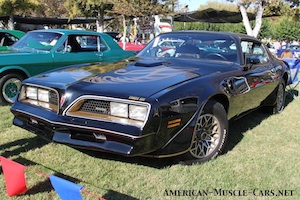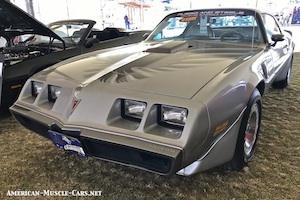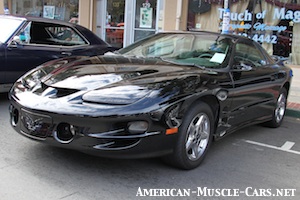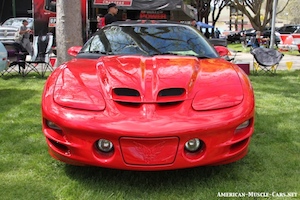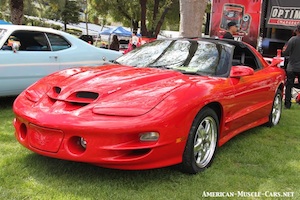Pontiac Firebird
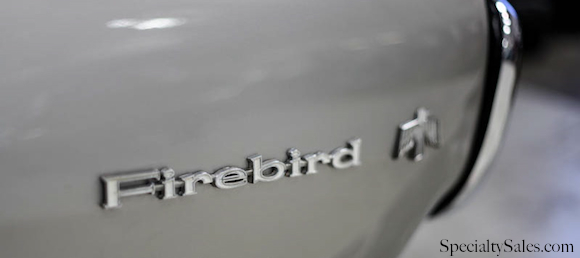
PONTIAC FIREBIRD
BORN TO BEAT THE MUSTANG
Of course everyone knows that the Pontiac Firebird and the Chevrolet Camaro were built in response to the Ford Mustang, which came out as a late 1964-model. GM and the rest of the industry was caught flat-footed and so scrambled to respond. They wanted their car to be better than the Mustang by every measure. GM brass felt it should be a Chevy, but John Z. DeLorean, chief engineer at Pontiac at the time would have none of it. He wanted a version for Pontiac’s stable as well. He pulled some strings and got it done.

ABOVE: 1967 Pontiac Firebird 400 Coupe. All 400s had hood scoops like this one.
DESIGNING THE PONTIAC FIREBIRD
Many ideas were bantered about for the new Chevy Camaro but the one that seemed to have the most legs was to base the new car on the lightweight Chevy II chassis, in the same way that Ford built the Mustang on the bones of the humble Falcon. But, Chevy engineers couldn’t get the ride and handling right on it, so the decision was made to bump up to the soon-to-be-reengineered Chevy Nova chassis. This meant it would be a semi-unibody with a bolt-on front subframe. They got into the development process early enough that the chassis was optimized for Camaro/Firebird duty, then adapted to the Nova, rather than the other way around. This made for a more substantial car, with better handling, more passenger and trunk space, and more room under the hood for big engines. It took GM almost 2-1/2 years to introduce their response to the game-changing Mustang, but when they did, the world paid attention.
PONTIAC FIREBIRD-LOADS OF OPTIONS
A hallmark of GMs approach to the Pony Car was to offer several models of essentially the same car, then load it up with options, in contrast to the Mustang, which was available in only one basic model with infinite options (including the GT package), Pontiac broke the Firebird lineup into 5 distinct models, based on their engines. The base car was simply called the “Firebird” and was powered by a 3.8 liter OHC (overhead cam) inline 6 with a -barrel carb wheezing out 165 hp. Next up was the “Firebird 326”, with a 326 V8 with 2 barrel carb, making 250 hp. Above that, in price if not in horsepower, was the “Firebird Sprint” with a hotter 4-barrel version of the OHC 6 making 215 hp. Then, the performance versions started with the 4-barrel “Firebird 326 H.O.” firing off 285 hp. On top of the heap was the “Firebird 400” with 325 hp 400 V8. Each was treated by Pontiac’s marketing department as a separate model.
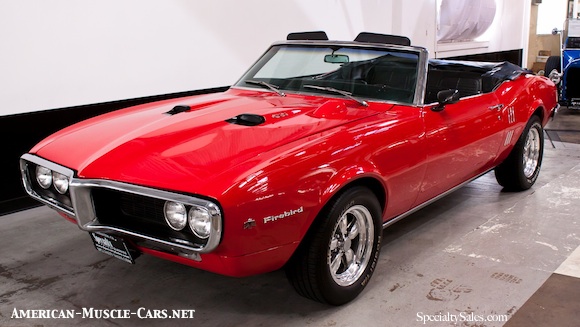
ABOVE: This is a ’68 Firebird 400 Convertible. Again distinguished by the twin hood scoops. 350s came without scoops.
PONTIAC FIREBIRD-LATE TO THE PONY CAR PARTY
The Chevy Camaro came out first, on September 26, 1966. The Pontiac Firebird followed on February 23, 1967. Pontiac felt it needed the extra four months to fully refine the chassis it shared with the Camaro in several key areas. The Firebird’s engine and transmission were set slightly farther back than in the Camaro, to improve the front-to-rear weight bias, and the suspension was beefed up and made generally stiffer for better handling, at the price of ride quality.

ABOVE: 1st-Gen F-body interiors were clean, simple and functional. The seats weren’t the greatest, especially on long trips.
PONTIAC FIREBIRD-NOT JUST A TARTED UP CAMARO
PMD (Pontiac Motor Division) engineers wanted to cook plenty of ‘Pontiac-ness’ into the F-body platform that it shared with the Camaro, and so while sharing front fenders, doors, rear quarters, roofs and glass, they managed to totally differentiate the car with a new hood, front and rear facias, wheels and interiors. And let’s not forget about Pontiac’s own proprietary family of engines. The Firebird had a totally different look and attitude than its sibling. And it wasn’t all looks and flair, there was some substance to it. It had a different engine, a drove differently, handled better, some say it was faster. In other words, the Firebird wasn’t just a Camaro with a different grill.

ABOVE: One of the most beautiful cars of its time, maybe of any time…that’s my opinion anyway. The 2nd-gen Pontiac Trans Am started a revolution that lasted 3 more decades. This one’s a ’73. Oh, and the rest of the 2nd-gen Firebird line wasn’t bad either.
PONTIAC FIREBIRD THROUGH THE AGES
Government-mandated emissions, fuel economy and safety standards landed like a ton of bricks on the American auto industry in the early 70s, and got so bad that many formerly hallowed nameplates went away. By 1974, the Dodge Challenger, Plymouth Barracuda, Olds 442, Buick Grand Sport, and Pontiac’s own GTO were gone. Those that remained had their performance castrated to such a level that you could barely consider them muscle cars anymore. The Ford Mustang became the 4-cylinder, Pinto-based Mustang II, the Plymouth Road Runner and Dodge Superbee became bloated luxury cars, and by 1975 Chevrolet thought it best to drop the Z/28 model altogether, moving the Camaro away from performance and toward a luxury-bias. (The Z/28 nameplate returned in ’76.) What remained? The only true muscle cars left through the 1970s were the Corvette (which some would say is a ‘sports car’, not a true ‘muscle car’), and the Pontiac Trans Am.

ABOVE: A cultural icon, this ’78 Trans Am sported the same black-and-gold livery as the car that starred in the hit movie “Smokey and the Bandit” also starring Burt Reynolds.
KEEPING THE FIRES BURNING
Unlike virtually everyone else in the industry at the time, Pontiac, did not drop its big-bore engines. Everyone else was downsizing, big blocks were replaced by wheezing, smogged-up small blocks. But Pontiac seemed to go in the other direction, when it came to the Firebird and Trans Am. By the mid-70s, virtually no one fielded a V8 engine larger than about 350 to 360 cubic inches. Pontiac had a 400, a 403 and a 455. They still had high-output engine (designated H.O.) and still leaned heavily on performance in all their advertising. And it’s a good thing too. Because American still wanted its muscle cars, and now Pontiac had the market virtually all to its self. It didn’t hurt that a Trans Am starred in a little movie called “Smokey and the Bandit” (also starring Burt Reynolds), which skyrocketed black Trans Am sales. It would take until the mid-1980s for true performance to make a comeback. But this time it would be electronic technology, not cubic inches, that would power the new Muscle Car Era. It really started in 1985 with GMs introduction of the TPI (Tuned Port Injection) V8 family. It was the first time horsepower crept over the 200-mark since the very early-70s (and this was now nethorsepower). And that was just the beginning. It would get better and better every year.
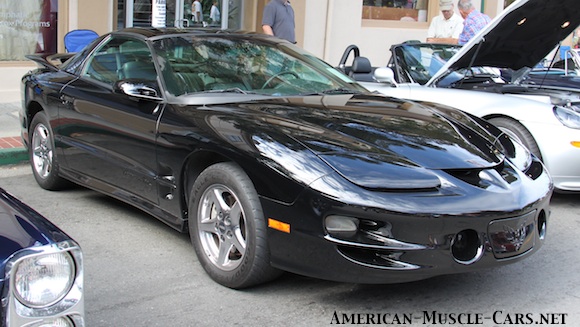
ABOVE: This ’99 Trans Am shows just how far they had come.
THE DEATH OF THE PONTIAC FIREBIRD
Of course, at the time, no one realized just how bad the situation was at GM, or that, in a few short years, the Pontiac brand itself would be on the chopping block. So, it came as a real shock when it as announced that the Pontiac Firebird (and Trans Am) would be dropped after the 2002 model year. Sales were slow, and GM brass felt that many of those sales were being pirated from potential Camaro sales. So, after 35 glorious years, the Pontiac Firebird and Trans Am were relegated to history’s junk pile. They will be sorely missed.
BELOW: This 2002 Trans Am is reputed to be the very last one ever built.
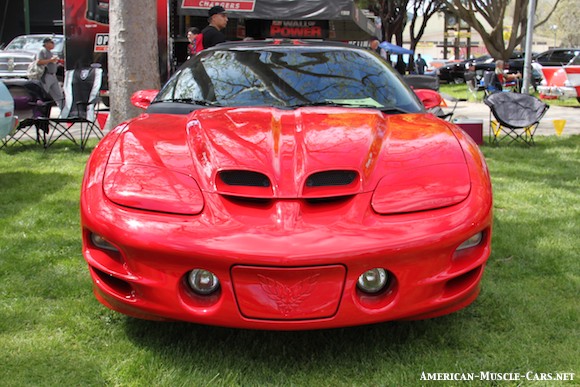
Pontiac Trans Am
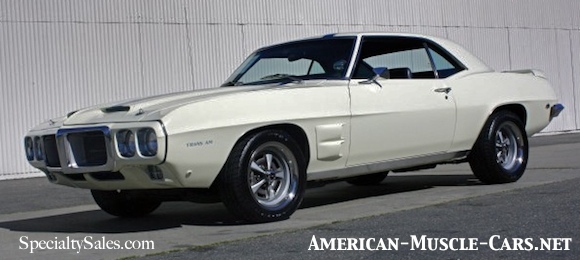
ABOVE: 1969 Pontiac Trans Am.
PONTIAC TRANS AM
When Pontiac launched the Firebird line in 1967, it was lacking an ultimate performance version like the Z/28 was to the Camaro line. It took until 1969 to field just such a car. By this time SCCA (Sports Car Club of America) Trans Am racing was red hot. The Camaro Z/28, the Mustang Boss 302, the Cuda AAR and Challenger T/A were all fielded on the track, and rushed to market to capitalize on the sales bonanza. Pontiac wanted something better, so the Trans Am was born. It got the best of everything, the best motor, transmission, rear end, brakes and suspension, along with some cool new body add-ons that gave the car a whole new look and attitude. It was an immediate hit, just as the First-Generation was winding down. It was truly the 2nd-gen (1970-1981) that put the Trans Am on the map for most Americans.
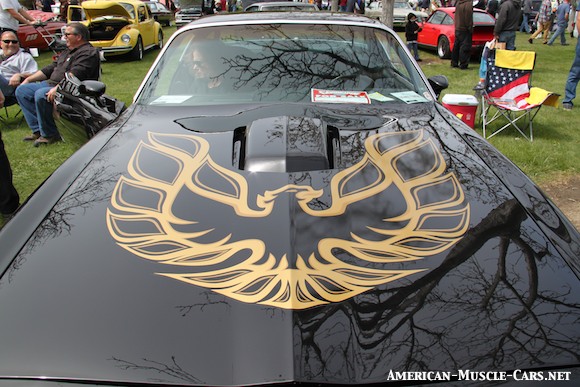
ABOVE: “The Screaming Chicken” as it became known, on the hood of a ’78 Trans Am, just like the ’77 T/A used in the movie “Smokey and the Bandit”.
TRANS AM IS NOT A FIREBIRD!
Interestingly, Pontiac chose not to make the Trans Am an upgrade to the Firebird lineup. Instead, the broke it out into its own model. So, where a Z/28 was actually a Camaro Z/28, and the Mach I was actually a Mustang Mach 1, the Pontiac Trans Am was just that: a Pontiac Trans Am. It was not called a Firebird Trans Am, not by Pontiac anyway. Not in their advertising, literature, or ordering system. There were Firebirds, then there were Trans Ams, considered by Pontiac to be two distinctly separate car lines.

ABOVE: This 1987 Trans Am GTA is typical of a 3rd-gen T/A. The GTA was the top-line Trans Am version with all the luxury options standard.
TRANS AM ENDURES
Where most of the rest of the industry gave up their muscle car aspirations by the mid-70s, Pontiac was just picking up steam. Where most cars were getting smaller, with smaller, weaker engines, the Trans Am managed to keep its displacement above 400 cubic inches throughout the 2nd-generation. It was truly the only muscle car in a once-crowded market, and it must have been very good for Pontiac. The Trans Am was their ‘halo car’. It lasted 4 generations, finally giving up the ghost in 2002.
BELOW: ’99 Trans Am.
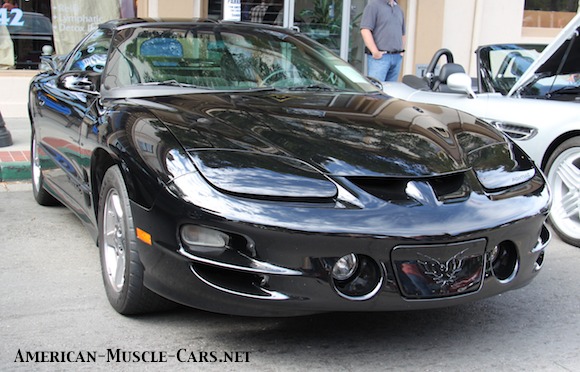
4 Generations of PONTIAC FIREBIRD
1st-GENERATION Pontiac Firebird, 1967-1969

ABOVE: This 1969 Firebird Convertible presents a fine example of a 1st-Gen Firebird.
PONTIAC FIREBIRD FIRST GENERATION
The First-Generation of Pontiac Firebird runs from 1967 through the 1969 model years. The ’67 and ’68 were very close in appearance, sharing almost everything cosmetically, with only the most subtle differences. The biggest was that the ’67 has side vent windows and the ’68 did not. The ’68 had flow-through ”Astro Ventilation” which included eye-socket air vents in the dash. The ’68 got side marker lights, the OHC 6 went from 3.8 liters to 4.1 liters, and the 326 cubic inch V8 was bored out to a 350. But in 1969, the Firebird was completely reskinned, along with its sister-car the Chevy Camaro for a new look, even though it was essentially the same car underneath. The Trans Am was introduced for the first time in 1969, selling just 689 coupes and 8 convertibles (talk about rare). The ’69 model year was a long one for the Firebird, but it didn’t help sales, at only 87,708 total units.
2nd-GENERATION Pontiac Firebird, 1970-1981
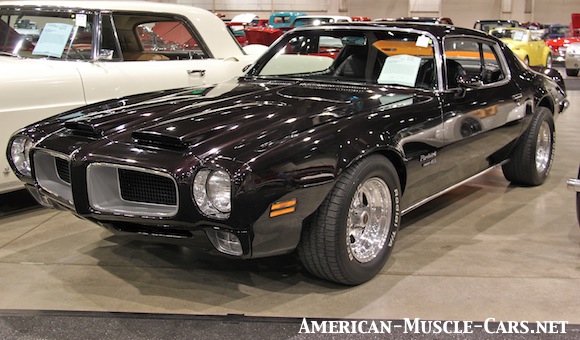
ABOVE: The 1970 Firebird had an elegant new design, shared again with the Chevy Camaro, that lasted through 1973. The 2nd-generation had no convertible option.
BELOW: Federally-mandated crash safety standards forced this new “cattle-catcher” front end.

This ’74 TransAm shows the first facelift for the 2nd-generation, not its best look, but still a tough looking car, nonetheless.
BIG CHANGES FOR THE 2nd-GEN PONTIAC FIREBIRD. A completely new car was introduced late in the 1970 model year, which many have to come call 70-1/2 models (like with the same-year Camaro). Long, sleek, influenced by European exotics of the day, the 1970 Firebird was stunning, and looked totally modern when compared to the car it replaced. Available only as a 2-door hardtop (the second-generation never offered a convertible option), it featured a one-piece Endura nose with split grille openings and singled headlights molded in, with a fastback shape and a Kamm tail in back. Many of the mechanicals were largely carried over but many were redesigned and/or improved. Special attention was lavished on the suspension to improve the handling and the ride quality.

ABOVE:SD stood for “Super Duty”, and the SD455 was the last truly fast engine on the road in 1974. Note the “shaker” hood scoop mounted to the air cleaner.
BELOW: You’ve gotta’ love that “Screaming Chicken”!
ABOVE: The 1977-78 Trans Ams were very handsome cars, and made famous by “Smokey and the Bandit”.
GROWING LONG IN THE TOOTH Pontiac did better than almost any other automaker at the time at retaining some semblance of performance through the dark, Smog Dog days of the 1970s. But despite their best efforts, continual pressure to improve mileage, reduce emissions and make cars safer took their toll. By the mid-70s, even the mighty Trans Am was a mere shadow of its former self. But a movie called “Smokey and the Bandit” starring Burt Reynolds and a black-and-gold 1977 Trans Am changed all that, selling more cars than any ad could have done. But by this time, the entire Firebird and Camaro lines were growing overweight and underpowered, they’d run their course. The 2nd-gen ran from 1970 through 1981.
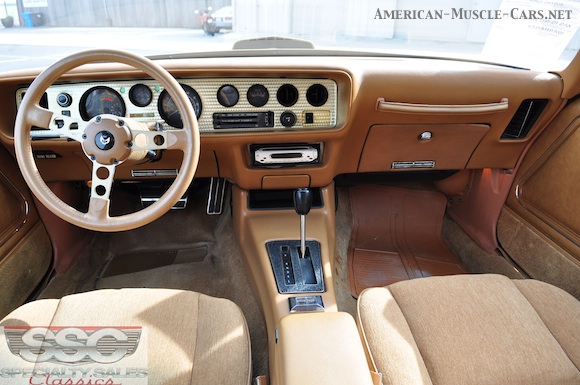
3rd-GENERATION Pontiac Firebird, 1982-1992
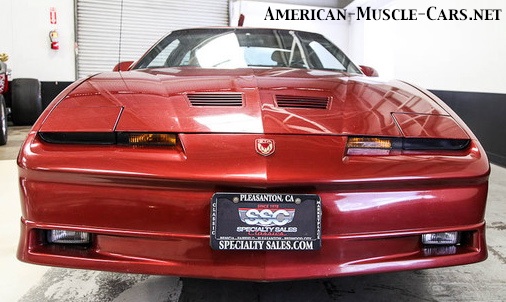
3rd-GEN USHERS IN THE MODERN AGE These 3rd-gen F-bodies brought the Firebird & Trans Am into the modern age, with 5 speed manuals, 4-speed autos with overdrive, modern port fuel injection, and state-of-the-art (for the time) electronics. Horsepower was back & growing fast. When TPI (Tuned Port Injection) was introduced in 1985, cars started exceeding 200 horsepower again, for the first time since 1970. The 5.7 TPI V8 available in the Firebird Formula and Trans Ams, when equipped with the G92 package (which included dual catalytic converters) was rated at 245hp, the same as the Corvette at this time.
ABOVE & BELOW: 1987 Trans Am GTA, the top-of-the-line 3rd-Gen Trans Am.
ABOVE: ’91 Trans Am with 5.7 TPI, nearing the end of the 3rd-generation
CHEVY ENGINES IN A PONTIAC? The new 3rd started with the 1982 and ran through the 1992 model year. The cars were totally redesigned, made smaller by nearly every dimension, and about 500 pounds lighter. And for the first time, the Pontiac Firebird lineup used Chevy engines. GM had made the decision to axe all the redundant engines that had always been proprietary to each brand. In fact the only Firebird that carried a Pontiac engine was the base car with the horrible “Iron Duke” 4 cylinder. Next up was the Chevy 2.8 OHV V6 (later punched out to 3.1 liters in 1991), and the Chevy 5.0 (305) V8. Top-line Trans Ams started out the 3rd-generation with the option of the 5.0 V8 with “Crossfire Injection” (a dual throttle body fuel injection system that was gone within a year). The non-Crossfire V8s all had 4-barrel carburetors until 1985 when TPI (Tuned Port Injection) became an option on the 5.0 V8, and a new throttle-body injection system for normal-duty 5.0’s starting in 1988. The 5.7 (350) V8 became available starting in 1987 but only with a 700R4 automatic transmission. The 5-speed manual gearbox they were using at the time couldn’t handle the torque of the 5.7 TPI. But they were able to make it work with a 5.0 TPI, so any 3rd-gen 5-speed TPI V8 Firebird or TransAm will be a 5.0, not a 5.7.
4th-GENERATION Pontiac Firebird, 1993-2002
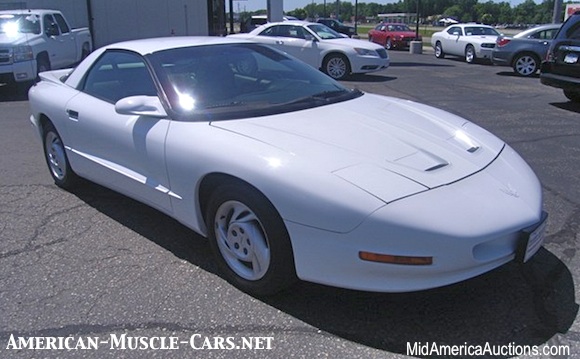
ABOVE: A ’93 Firebird Formula, the first year of the 4th-generation.
4th & FINAL GENERATION OF PONTIAC FIREBIRD The 4th-generation launched with the latest generation of Corvette engine, the LT1 5.7 liter V8, now making 375 hp in the Firebird (it made 400 hp in the Vette because of a freer-flowing exhaust route), and the horsepower steadily climbed, always just a step behind the Corvette, until GM pulled the plug on both the Chevy Camaro and the Pontiac Firebird in 2002. It was a bitter end to a long and hallowed career of tire-smoking, drag-racing, rubber-burning, brodie-spinning and generally hauling ass. The entire Pontiac brand was shuttered in 2009 as part of GMs ‘restructuring’. May it rest in peace.
BELOW: 1999 Pontiac Trans Am. By this time, they had developed into incredibly-fast, excellent-handling, great-driving cars, that were also comfortable, practical and easy to drive fast.
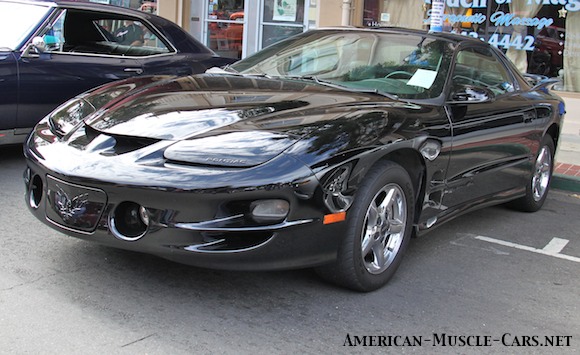
Pontiac Firebird & Trans Am YEAR-BY-YEAR
The first year for Pontiac’s F-body (twin to the Chevy Camaro, but decidedly…different. 5 engines, 5 different models, Coupes, Convertibles and dozens of options. On its way to becoming a legend!
Second year of the 1st-generation, it was largely carryover from the ’67. Vent windows are gone, the 3.8 got stroked out to a 4.1 and the 326 V8 was bored out to a 350. Horsepower rose commensurately.
F-body goes European. 215hp 4.1-liter SOHC inline-six, focus was on handling.
3rd and final year of the 1st-generation, the ’69 gets a total reskin. Engines, trannies & mechanicals remain more or less unchanged. The Trans Am is born mid-year, albeit in very small numbers.
Kicks off the 2nd-generation with a bang. Sexy new lines, more power, more refinement, but no convertible.
First year of the 2nd-generation, a new body, a new shape & even more power! Sales were soaring too.
Mostly carried-over from 1970 with a few styling & feature tweeks. Power is slowly waning as increasing federal regs kill performance on all fronts.
Mostly carried over from 1970, new colors combos, more options, more safety & smog stuff.
’73 marked the last year of the early 2nd-gen Firebirds, with their graceful noses. Crash regs force a new, less pretty nose starting the following year.
Last year for the graceful looks of the early 2nd-gen. Even smogged-out the big 455 4bbl still kicked out the jams. Trans Am was just about the only true Muscle Car left in the 70s.
First year for the new crash-mandated front end. Power is down and falling fast. But Pontiac manages to keep pulling it off somehow.
1974 TRANS AM
First year for the ‘cattle-catcher’ front end, last year for the 455 Super Duty.
Yet another new front facia, with integrated bumper, better aerodynamics & much better looks.
Despite a drastic drop in performance across the board, the mighty Trans Am continues to beat the odds. They weren’t fast, but they were faster than just about anything else at the time.
First year for the new look. Special Black Edition debuts & sells like hotcakes thanks to the movie “Smokey & the Bandit”.
Pontiac was still building muscle cars. The smallest engine you could get in a ’78 T/A was a 400 big block. Gold Special Edition debuts. Black & Gold “Smokey & the Bandit” paint combo continues. New T-Tops.
The last facelift of the 2nd-generation gives it a new ‘snorky’ nose cone with recessed headlights. Not as pretty as the ’77-’78.
The mighty T/A thunders out of the 70s with a 6.6L (403 cid) Olds V8, making it the only ‘big block’ muscle car left on the market.
Early in the 3rd-generation, the hottest engine in the lineup was the 5.0 H.O. (High Output) V8 with a wheezing 190hp.
The 3rd-gen is lighter & with new TPI V8s, faster than before. The GTA, or Grand Trans Am was the premium version. Top engine was the 5.7 TPI V8 w/245hp, same as the ’87 Corvette.
This 3rd-gen Formula packed a 5.7 (350) TPI, same as the Trans Am, but without all the body add-ons.
The GTA was the top-line Trans Am w/5.7, leather, special wheels, emblems, etc. They got the best of everything!
1994 TRANS AM 50th ANNIVERSARY
Pontiac built 1,750 50th Anniversary Coupes to celebrate the Trans Am’s 50th birthday. The all-white T/A had a narrow blue racing stripe to commemorate the original 1969 Trans Am.
4th-gen Trans Ams are amazing! Corvette power, great handling, aggressive styling, & they were seriously fast!
’02 was the last year for Firebird & Trans Am production…and this car is literally the last Trans Am to roll off the assembly line!
YouTube Video: “The Last Trans Am”.
A virtual walk-around, up close & personal with this drop-dead gorgeous 2002 Trans Am. You’ve heard the story: this is supposed to be the last Trans Am to roll off the assembly line.
Eye-popping pictures, specs, history & more on Pontiac Trans Ams, broken down year-by-ear, generation-by-generation.




